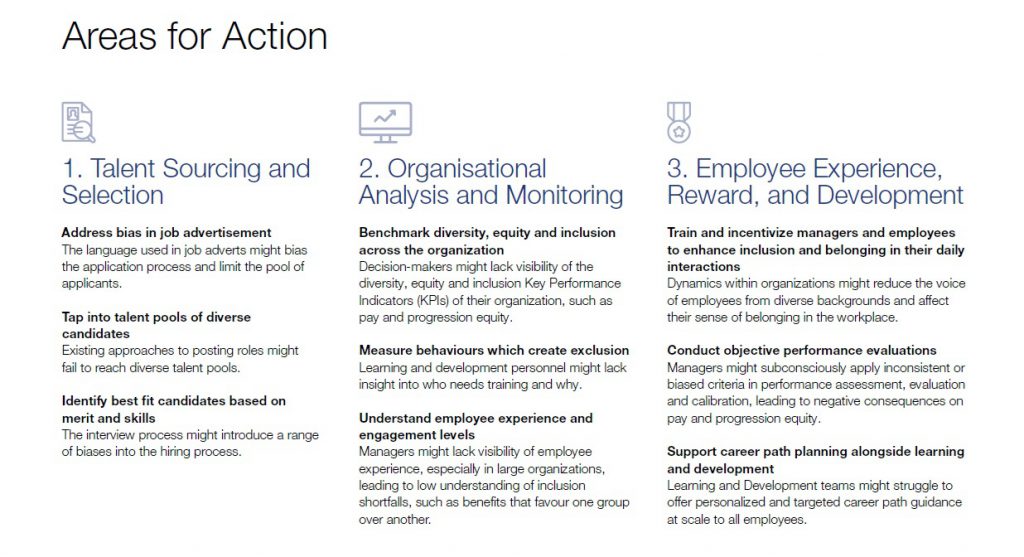A 10 minutes read.
By Vishal P Pandey
‘DEI’- the building blocks of an organization
The start of the decade has seen a convergence of three major trends: the accelerated use of Fourth Industrial Revolution technologies in the midst of the pandemic, job market disruptions to both remote work and work requiring physical presence, and a wide-ranging call for greater inclusivity, equity and social justice. Now more than ever, in the
midst of such sweeping change, organizations have an opportunity to embed greater diversity, equity and inclusion. Societal change and the need for future creativity and innovation demand that business consider the best use of new technologies in enabling this journey.
Successful organizations are powered by the diverse opinions, skill sets and life experiences of their employees. To tap into the full potential of human diversity, organizations need to hire diverse talent and create an inclusive working culture underpinned by a fundamental sense of belonging, fairness and equity, enabling people to bring their “full self”
to work.
We cannot tell people to trust us. We cannot instruct people to come up with big ideas. And we certainly can’t demand that people cooperate. These are always results—the results of feeling safe and trusted among the people with whom we work.
Roderick M. Kramer- Rethinking Trust HBR
Many successful companies regard I&D as a source of competitive advantage. For some, it’s a matter of social justice, corporate social responsibility, or even regulatory compliance. For others, it’s essential to their growth strategy.
Diversity is like mixing of different layers
Diversity is the representation of all our varied identities and differences (race, ethnicity, gender, disability, sexual orientation, gender identity, national origin, tribe, caste, socio-economic status, thinking and communication styles, etc.), collectively and as individuals. Diversity seeks to seek to proactively engage, understand, and draw on a variety of perspectives. Diversity can be the engine of innovation and research.
The most innovative company must also be the most diverse. We take a holistic view of diversity that looks beyond usual measurements. A view that includes the varied perspectives of our employees as well as app developers, suppliers, and anyone who aspires to a future in tech. Because we know new ideas come from diverse ways of seeing things.
Apple Inc., “Open,”
We need to understand that the path towards realizing a better place for our society, our nation, and the entire humanity on whole can be found by affirming our similarities, as well as by finding value in our differences.
In fact as pointed out in the previous article Schools of the Future, the World Economic Forum has identified ‘Global citizenship skills’ as one of the eight critical skill shifts required for 21st Century. Diversity is certainly imperative to develop these global citizenship skills. Check the complete article.

Inclusivity; the feeling of belongingness
Inclusion builds a culture of belonging by actively inviting the contribution and participation of all people. At workplaces and organizations the logic behind prioritizing inclusion alongside diversity is becoming more evident. Various reports and researches have established evidence that inclusion is closely linked to employee engagement, itself in turn a critical component of employee retention, productivity and financial performance.
An inclusive culture is about more than just policies – it’s about making genuine changes to how the company operates. It is essential that all organizations create an environment where talent from all backgrounds can thrive and feel comfortable, so they can advance their careers along with the organization goals.
Holistic definition of Inclusion: Deloitte’s inclusion model
First, people feel included when they are treated “equitably and with respect.” Participation without favoritism is the starting point for inclusion, and this requires attention to nondiscrimination and basic courtesy.
The next element relates to “feeling valued and belonging.” Inclusion is experienced when people believe that their unique and authentic self is valued by others, while at the same time have a sense of connectedness or belonging to a group. At its highest point, inclusion is expressed as feeling “safe” to speak up without fear of embarrassment or retaliation, and when people feel “empowered” to grow and do one’s best work.
Balancing the ladder through equity
Equity is the quest to ensure fair treatment, equality of opportunity, and fairness in access to information and resources for all. Equity is more of a state than a step, and it’s hard to strictly define what it looks like since it’ll be different for every organization or institute. But in general, equity is what happens when all members of a diverse population of employees have equal opportunities and support to succeed and grow. Equity is born naturally from establishing a diverse, inclusive and equal workplace or culture.
At Slack, we understand talent is evenly distributed—opportunity is not.
Deepti Rohatgi, head of Slack for Good & Public Affairs
At VIT we feel the best way to approach equity is to work backward. We need to start with considering what’s important to all our students and staff, and what equity would look like to them. For an educational institute like us equity has equal relevance for both staff members and students. For staff it is about authority, pay, growth, and success opportunities. For students it is equal opportunity to learn and grow, to participate and be part of all activities and processes.
Equity Isn’t Synonymous with Equality
Often people tend to confuse equity with equality — and though they’re only two letters apart, they actually have very different meanings. These differences go beyond mere semantics.
Companies that strive for workplace equality (treating everyone the same, without discrimination) may not factor in the need for equity. The entire workforce comes under the same blanket of rules, privileges, and employee experience design, without an eye on unique, demographic-related needs. This may lead to an unfair work environment. Equity, on the other hand, attempts to identify the specific needs and requirements informed by demographic traits such as ethnicity, nationality, age, gender, etc. It then tries to address the differing needs of each group by bridging the gap between minority and majority groups. This makes equity central to the genuine empowerment of minority groups (and not just theoretical equality).
Equality is providing the same meal full of meat for everybody, knowing that you have vegans and vegetarians in the group.
Amelia Ransom, Senior director of engagement and diversity, Avalara
Equity is providing vegan and vegetarian options along with the meat meal so that everybody has something that they can eat. To have equity in your organization, there needs to be an understanding of what each person needs and wants to be successful in the workplace.
‘DEI’ in Indian Context
Diversity, Equity & Inclusion are bedrock for sustenance and existence of any community, society, or nation. When we consider a country as diverse as ours, these principles become sacrosanct and irreplaceable. We often revel in pride on diversity of region, culture, language, thought, belief, vegetation, climate, cuisine, and even the way people dress in our country. However this brings the added responsibility of retaining this diversity. Pluralism is not mere choice of thinking; it needs to be ingrained as a fundamental value. Our culture and history has pronounced and upheld egalitarianism.
She (India) was like some ancient palimpsest on which layer upon layer of thought and reverie had been inscribed , and yet no succeeding layer had completely hidden or erased what had been written previously
Jawaharlal Nehru, The Discovery of India
We need to understand a basic fact that diversity without inclusion and equity is simply unacceptable and unbearable. Any society cannot survive in long term without inclusion and equity. In fact abhorring inclusion simmered into catastrophes like ethnic cleansing, and holocaust which brought unfathomable harm to the world on whole. It is really strange to note repetition of such incidences throughout the human history. But then German philosopher Georg Hegel famously said, “The only thing that we learn from history is that we learn nothing from history.”
Role of DEI in an educational institute
There cannot be a place more important than an educational institute to start discourse on values of Diversity, Inclusion, and Equity. The young pallbearers of future need to understand and appreciate these; which would serve as a starting path towards holistic education. Young lives shaped in atmosphere which accepts and promotes diversity, inclusion, and equity will certainly carry these traits in their later lives, improving the society on whole.
We feel the first step would Diversity; the need to attract diverse thought and talents in both students and staff. The next step is inclusion. An inclusive work environment is one in which leaders are vocal about encouraging everyone to share their contributions and, when done well, make all staff and students feel valued through positive reinforcement and clear outcomes. When all staff and students feel empowered to bring their unique thoughts and ideas to the table, they know they’re being valued equally — that’s equality. If all three of these stages are met, then equity will occur naturally. Equity is more of a state than a step, and it’s hard to strictly define what it looks like since it’ll be different for every organization or institute.
It is noteworthy to note that only on governments, but many organizations round the world the working to promote DEI in educational institutes.
Our work to diversify the STEM pipeline into colleges and universities starts with generating excitement for tech as early as possible. Through a range of initiatives and partnerships, we’re trying to reach the future generation of talent (K-12, high schoolers) as early as possible. Our goal is to help them grow their skills, discover a passion for tech, and envision a future filled with possibility.
Microsoft, Employee Career & Development
Road Ahead
Changing demographics are significantly impacting the workforce. People are living longer and working older; many employers now have five generations to motivate and manage; and the global movement of people is evolving available talent pools. In this changing environment, cultivating a diverse and inclusive approach to talent is more critical than ever.
Today believe businesses have a responsibility to enable all people to participate in the workplace and achieve their potential. Fostering a diverse inclusive workplace can bring a number of benefits – from the ability to adapt more easily to shifting market and consumer demands, to allowing organizations to deliver a broader range of services, harnessing the wide collection of skills and experiences they have within their company.

We recognize that there is no ‘quick-fix’ response to getting this right. Attracting, advancing, developing, engaging and retaining a diversity of talent while fostering an inclusive culture – one where difference is valued and embraced – is not easy. Understanding the importance of DEI, and the values added advantages we can derive from it would definitely be the first step.
Our success as a species was not luck—it was earned. We worked hard to get to where we are today and we did it together. We’re built to work together. We are, at a deeply ingrained and biological level, social machines.
Simon Sinek- Leaders eat last
References
- Word Economic Forum Report- Diversity, Equity and Inclusion 4.0: A toolkit for leaders to accelerate social progress in the future of work
- The diversity and inclusion revolution: Eight powerful truths
- Why diversity matters
- Delivering through Diversity- Mckinsey Report, January 2018
- Diversity Wins, How Inclusion Matters- Mckinsey Report, May 2020
- 5 Reasons to Focus on Workplace Equity Alongside Diversity and Inclusion
- The Difference Between Workplace Equity And Equality, And Why It Matters- Forbes.com
- Cultivating diversity and inclusion- Deloitte Article
- Diversity and inclusion: A formula for success
- Rethinking Trust- HBR article by Roderick M. Kramer

